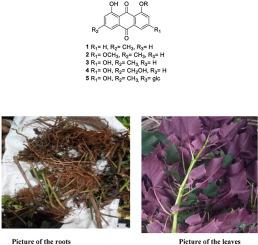当前位置:
X-MOL 学术
›
Biochem. Syst. Ecol.
›
论文详情
Our official English website, www.x-mol.net, welcomes your
feedback! (Note: you will need to create a separate account there.)
Anthraquinones and other constituents from the roots of Eremomastax speciosa (Hochst.) Cufod
Biochemical Systematics and Ecology ( IF 1.4 ) Pub Date : 2021-02-01 , DOI: 10.1016/j.bse.2020.104196 Yolande Noëlle Nangue Djouatsa , Willifred Dongmo Tékapi Tsopgni , Edwige Laure Nguemfo , Livie Blondèle Kenou , Yannick Fouokeng , Ahri Bernie Djamen Mbeunkeu , Alain Bertrand Dongmo , Anatole Guy Blaise Azebaze
Biochemical Systematics and Ecology ( IF 1.4 ) Pub Date : 2021-02-01 , DOI: 10.1016/j.bse.2020.104196 Yolande Noëlle Nangue Djouatsa , Willifred Dongmo Tékapi Tsopgni , Edwige Laure Nguemfo , Livie Blondèle Kenou , Yannick Fouokeng , Ahri Bernie Djamen Mbeunkeu , Alain Bertrand Dongmo , Anatole Guy Blaise Azebaze

|
Abstract The chemical investigation of the roots of Eremomastax speciosa (Hochst.) Cufod (Acanthaceae). led to the isolation of thirteen compounds including five anthraquinones 1,8-dihydroxy-3-methylanthraquinone (1), 1,8-dihydroxy-3-methoxy-6-methylanthraquinone (2), emodin (3), aloe emodin (4) and 8-O-D-glucopyranosideemodin (5); one phenylethanoid glucoside acteoside (6); one benzophenone 2,6-dimethoxybenzophenone (7); two pentacyclic triterpenoids lupeol (8) and betulinic acid (9); three phytosterols stigmasterol (10), β-sitosterol (11), and β-sitosterol-3-O-β-D-glucopyranoside (12) and one fatty acid hexadecanoid acid (13). All these compounds are firstly reported from the roots of E. speciosa. Emodin and acteoside were modified chemically through allylation reaction to afford 3-O-allylated emodin (3a) and a new perallylated acteoside derivative (6a), respectively. The structure of the isolated compounds as well as those of the allylated derivatives were established by means of spectroscopic methods: NMR analysis (1H and 13C NMR, 1H–1H–COSY, HSQC and HMBC), high-resolution mass spectrometry (HR-ESI-MS) and by comparison with previously reported data. All those compounds were tested for their cytotoxic activity against the human cervix carcinoma KB-3-1 cells and their antioxidant activity, the allylated acteoside derivative and 2,6-dimethoxybenzophenone showed weak cytotoxicity while acteoside showed a good antioxidant activity. In addition, the chemotaxonomic significance of the isolated compound is discussed.
中文翻译:

来自 Eremomastax speciosa (Hochst.) Cufod 根的蒽醌和其他成分
摘要 Eremomastax speciosa (Hochst.) Cufod (Acanthaceae) 根的化学研究。导致分离出 13 种化合物,包括五种蒽醌类 1,8-二羟基-3-甲基蒽醌 (1)、1,8-二羟基-3-甲氧基-6-甲基蒽醌 (2)、大黄素 (3)、芦荟大黄素 (4)和 8-OD-吡喃葡萄糖苷大黄素 (5);一种苯乙醇苷(6);一二苯甲酮 2,6-二甲氧基二苯甲酮 (7);两种五环三萜类化合物羽扇豆醇 (8) 和桦木酸 (9);三种植物甾醇豆甾醇 (10)、β-谷甾醇 (11) 和 β-谷甾醇-3-O-β-D-吡喃葡萄糖苷 (12) 和一种脂肪酸十六烷酸 (13)。所有这些化合物都是从 E. speciosa 的根中首次报道的。大黄素和大黄素通过烯丙基化反应进行化学修饰,分别得到 3-O-烯丙基化大黄素 (3a) 和新的过烯丙基化的大黄素衍生物 (6a)。分离化合物的结构以及烯丙基化衍生物的结构通过光谱方法确定:NMR 分析(1H 和 13C NMR、1H-1H-COSY、HSQC 和 HMBC)、高分辨率质谱(HR-ESI -MS) 并与之前报告的数据进行比较。测试了所有这些化合物对人宫颈癌 KB-3-1 细胞的细胞毒活性和抗氧化活性,烯丙基化的牛油果衍生物和 2,6-二甲氧基二苯甲酮显示出较弱的细胞毒性,而牛油果显示出良好的抗氧化活性。此外,还讨论了分离化合物的化学分类学意义。分离化合物的结构以及烯丙基化衍生物的结构通过光谱方法确定:NMR 分析(1H 和 13C NMR、1H-1H-COSY、HSQC 和 HMBC)、高分辨率质谱(HR-ESI -MS) 并与之前报告的数据进行比较。测试了所有这些化合物对人子宫颈癌 KB-3-1 细胞的细胞毒活性和抗氧化活性,烯丙基化的醋栗衍生物和 2,6-二甲氧基二苯甲酮显示出弱的细胞毒性,而醋栗苷显示出良好的抗氧化活性。此外,还讨论了分离化合物的化学分类学意义。分离化合物的结构以及烯丙基化衍生物的结构通过光谱方法确定:NMR 分析(1H 和 13C NMR、1H-1H-COSY、HSQC 和 HMBC)、高分辨率质谱(HR-ESI -MS) 并与之前报告的数据进行比较。测试了所有这些化合物对人子宫颈癌 KB-3-1 细胞的细胞毒活性和抗氧化活性,烯丙基化的醋栗衍生物和 2,6-二甲氧基二苯甲酮显示出弱的细胞毒性,而醋栗苷显示出良好的抗氧化活性。此外,还讨论了分离化合物的化学分类学意义。高分辨率质谱 (HR-ESI-MS) 并与先前报告的数据进行比较。测试了所有这些化合物对人宫颈癌 KB-3-1 细胞的细胞毒活性和抗氧化活性,烯丙基化的醋栗苷衍生物和 2,6-二甲氧基二苯甲酮显示出弱的细胞毒性,而醋栗苷显示出良好的抗氧化活性。此外,还讨论了分离化合物的化学分类学意义。高分辨率质谱 (HR-ESI-MS) 并与先前报告的数据进行比较。测试了所有这些化合物对人子宫颈癌 KB-3-1 细胞的细胞毒活性和抗氧化活性,烯丙基化的醋栗衍生物和 2,6-二甲氧基二苯甲酮显示出弱的细胞毒性,而醋栗苷显示出良好的抗氧化活性。此外,还讨论了分离化合物的化学分类学意义。
更新日期:2021-02-01
中文翻译:

来自 Eremomastax speciosa (Hochst.) Cufod 根的蒽醌和其他成分
摘要 Eremomastax speciosa (Hochst.) Cufod (Acanthaceae) 根的化学研究。导致分离出 13 种化合物,包括五种蒽醌类 1,8-二羟基-3-甲基蒽醌 (1)、1,8-二羟基-3-甲氧基-6-甲基蒽醌 (2)、大黄素 (3)、芦荟大黄素 (4)和 8-OD-吡喃葡萄糖苷大黄素 (5);一种苯乙醇苷(6);一二苯甲酮 2,6-二甲氧基二苯甲酮 (7);两种五环三萜类化合物羽扇豆醇 (8) 和桦木酸 (9);三种植物甾醇豆甾醇 (10)、β-谷甾醇 (11) 和 β-谷甾醇-3-O-β-D-吡喃葡萄糖苷 (12) 和一种脂肪酸十六烷酸 (13)。所有这些化合物都是从 E. speciosa 的根中首次报道的。大黄素和大黄素通过烯丙基化反应进行化学修饰,分别得到 3-O-烯丙基化大黄素 (3a) 和新的过烯丙基化的大黄素衍生物 (6a)。分离化合物的结构以及烯丙基化衍生物的结构通过光谱方法确定:NMR 分析(1H 和 13C NMR、1H-1H-COSY、HSQC 和 HMBC)、高分辨率质谱(HR-ESI -MS) 并与之前报告的数据进行比较。测试了所有这些化合物对人宫颈癌 KB-3-1 细胞的细胞毒活性和抗氧化活性,烯丙基化的牛油果衍生物和 2,6-二甲氧基二苯甲酮显示出较弱的细胞毒性,而牛油果显示出良好的抗氧化活性。此外,还讨论了分离化合物的化学分类学意义。分离化合物的结构以及烯丙基化衍生物的结构通过光谱方法确定:NMR 分析(1H 和 13C NMR、1H-1H-COSY、HSQC 和 HMBC)、高分辨率质谱(HR-ESI -MS) 并与之前报告的数据进行比较。测试了所有这些化合物对人子宫颈癌 KB-3-1 细胞的细胞毒活性和抗氧化活性,烯丙基化的醋栗衍生物和 2,6-二甲氧基二苯甲酮显示出弱的细胞毒性,而醋栗苷显示出良好的抗氧化活性。此外,还讨论了分离化合物的化学分类学意义。分离化合物的结构以及烯丙基化衍生物的结构通过光谱方法确定:NMR 分析(1H 和 13C NMR、1H-1H-COSY、HSQC 和 HMBC)、高分辨率质谱(HR-ESI -MS) 并与之前报告的数据进行比较。测试了所有这些化合物对人子宫颈癌 KB-3-1 细胞的细胞毒活性和抗氧化活性,烯丙基化的醋栗衍生物和 2,6-二甲氧基二苯甲酮显示出弱的细胞毒性,而醋栗苷显示出良好的抗氧化活性。此外,还讨论了分离化合物的化学分类学意义。高分辨率质谱 (HR-ESI-MS) 并与先前报告的数据进行比较。测试了所有这些化合物对人宫颈癌 KB-3-1 细胞的细胞毒活性和抗氧化活性,烯丙基化的醋栗苷衍生物和 2,6-二甲氧基二苯甲酮显示出弱的细胞毒性,而醋栗苷显示出良好的抗氧化活性。此外,还讨论了分离化合物的化学分类学意义。高分辨率质谱 (HR-ESI-MS) 并与先前报告的数据进行比较。测试了所有这些化合物对人子宫颈癌 KB-3-1 细胞的细胞毒活性和抗氧化活性,烯丙基化的醋栗衍生物和 2,6-二甲氧基二苯甲酮显示出弱的细胞毒性,而醋栗苷显示出良好的抗氧化活性。此外,还讨论了分离化合物的化学分类学意义。









































 京公网安备 11010802027423号
京公网安备 11010802027423号